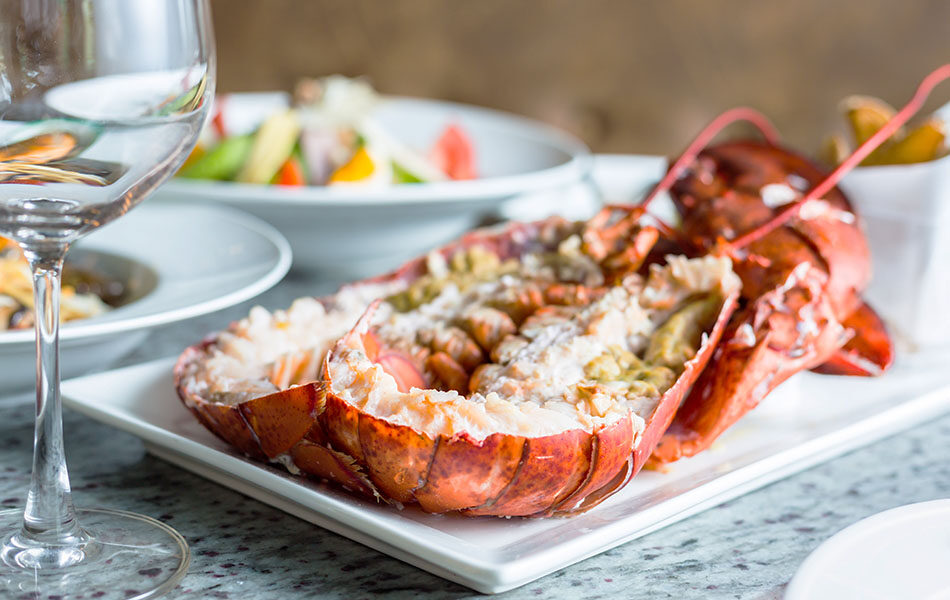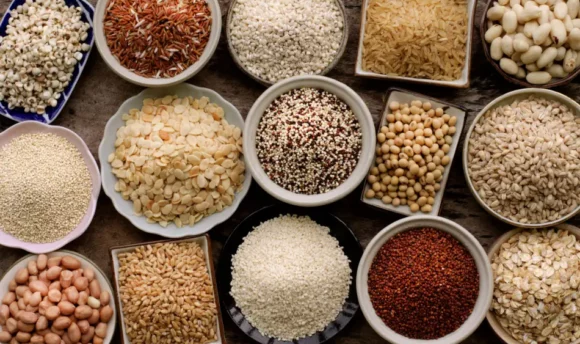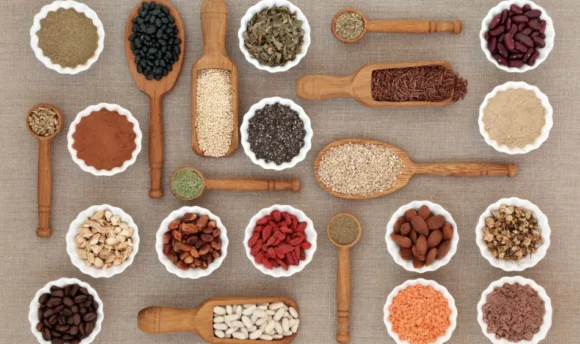Is Lobster Healthy? Nutrition Facts and Health Benefits
Lobster is a dish that is beloved by many and seems almost too delicious to be healthy. But can it be an addition to a well-balanced diet? Keep reading to find out.

When it comes to healthy proteins, lobster is a food that often flies under the radar. Maybe it’s because you find it slathered in butter or hidden inside a tasty, but not overly healthy, lobster mac and cheese.
You’re in the right place if you’re considering incorporating more lobster into your diet but aren’t clear on how it might affect your fitness goals.
Keep reading for more information on the health benefits of lobster and the potential risks of eating this delicious food.
Is Lobster Healthy?
Yes, lobster can be considered healthy. Although technically a high-cholesterol food, fresh lobster is low in saturated fats, full of omega-3 fatty acids, and contains various unique vitamins and minerals.
Unlike many other kinds of seafood, lobster is also considered mercury-safe, meaning that you won’t have to worry about ingesting as much of the harmful metal as you would when eating popular fish like tuna.
5 Health Benefits of Lobster
Looking to incorporate lobster into your diet? In this next section, we’ll outline the various health benefits you can glean by adding it to your plate.
#1 Full of omega-3 fatty acids
Lobster and some fattier fish like salmon and tuna are high in omega-3 fatty acids, a kind of polyunsaturated fat. Although most fat has a bad reputation for contributing to heart disease and causing unwanted weight gain, polyunsaturated fats actually have the opposite effect.
Studies have shown that increasing the consumption of foods high in omega-3 fatty acids, like lobster, can improve both heart and brain health. This is because omega-3 fatty acids can help lower blood pressure and HDL cholesterol levels while building blocks for creating healthy brain cells.
Other studies suggest that omega-3 fatty acids can even improve the weight loss process. Though, it’s important to note that the effects are modest and are not shown to work for everyone.
#2 Rich in protein
A 100g serving of lobster is shown to have up to 20g of protein, nearly half of the 54g daily recommendation for a 150lbs person. Also, lobster is high in most of the amino acids your body needs to synthesize muscle.
High-protein foods rich in essential amino acids are an important part of a healthy diet for several reasons. Anyone intent on losing weight can benefit from how slowly protein is digested by the body, which plays a part in curbing appetite.
Protein is also essential for protein synthesis and muscle recovery after a workout, making lobster a solid post-workout meal for anyone wanting to maximize muscle growth.
#3 High in vitamin B12
Another benefit of eating lobster is that it is high in vitamin B12, which you’ll find in high amounts in cooked meat, like beef and lamb.
Vitamin B12 has a number of brain-boosting benefits and has been shown to play a role in preventing brain atrophy, a process that contributes to Alzheimer’s and strokes.
On top of being great for brain health, vitamin B12 plays a major role in cell formation and the health of the nervous system. It is essential for the production of serotonin and dopamine, two neurotransmitters that are known for their mood-enhancing benefits.
#4 Contains selenium
One of the most underrated benefits of eating cooked lobster meat is related to the high amount of a trace mineral, called selenium, that it contains. A 100g serving of lobster has 46.2µg, which is almost 100% of the daily recommended amount of selenium, depending on the kind of lobster you choose to eat.
Selenium is involved in a variety of important bodily functions and has been shown to improve mental cognition and immune function and even affect fertility.
Studies have also proven selenium to be a strong antioxidant, helping to prevent the prevalence of free radicals in the body. Eating antioxidant-rich foods can lower inflammation in the body, lowering the risk of chronic oxidative stress-related diseases like heart disease and cancer.
#5 Low in saturated fat
Compared to many other protein-rich foods like red meat, lobster contains a fraction of the saturated fat and is therefore also considerably lower in calories.
While eating polyunsaturated fat can help to lower bad cholesterol, eating high-cholesterol food that is high in saturated fat puts you at a higher risk of heart and blood vessel disease.
Upping your lobster consumption is a great way to increase the amount of vitamin B12 and protein while reducing your blood cholesterol levels.
2 Downsides of Lobster
Despite offering many unique health benefits, there are certain risks that are associated with eating lobster. Being aware of these risks can help you make healthier choices regarding what you choose to eat.
#1 High in cholesterol
Lobster is high in dietary cholesterol, with a single serving of lobster containing 60% of the daily recommendation for cholesterol.
Although eating lobster generally doesn’t affect blood cholesterol levels, which are what contribute to heart disease, it’s important to moderate your consumption of high-cholesterol foods.
#2 May contain mercury
Lobster, along with other shellfish, contain considerably lower levels of mercury than other seafood. Regardless of being low in mercury, any foods that contain trace amounts of mercury should be consumed in moderation.
Mercury can have a detrimental effect on your nervous system and is especially harmful to young children and pregnant women.
Nutrition Facts of Lobster
Understanding the nutritional value of your food is essential if you want to start making healthier dietary choices. Here are some of the most important lobster nutrition facts.
Nutritional value per 100g
| Calories/Nutrients (per 100g) | Amount |
| Calories (kcal) | 112 |
| Net Carbs (g) | 2.43 |
| Fiber (g) | 0 |
| Sugar (g) | 0 |
| Fats (total) | 1.51 |
| Protein (g) | 20.6 |
| Sodium (mg) | 177 |
| Cholesterol (mg) | 70 |
Source: https://fdc.nal.usda.gov/fdc-app.html#/food-details/174211/nutrients
Low in calories
Compared to many other protein-rich foods, lobster is considerably lower in calories. A 100g serving of steamed lobster contains 112kcal, which is less than half of the 271kcal found in an equal portion of steak.
It is an ideal option for anyone wanting to reduce their calorie intake and lose weight.
High in protein
Lobster is high in protein while still being relatively low in fat. Because of this, it’s a great choice for anyone wanting to improve their athletic performance and maximize muscle growth.
Low in saturated fat
Healthy fats are an important part of any diet and can help with weight management, support healthy immune function, and even lower bad cholesterol. Because lobster is high in healthy fats and low in unsaturated fats, you can eat it in moderation without worrying about the effect it has on your cholesterol levels.
Rich in minerals and vitamins
Lobster contains a variety of essential vitamins and minerals, including zinc, phosphorus, selenium, vitamin B12 and E, and magnesium.
Crayfish vs. Lobster
| Lobster | Crayfish | |
| Meals used | Some meals in which lobster is used include lobster bisque, risotto, and lobster mac and cheese. The tails are also eaten on their own, often dipped in butter. | When cooking crayfish, it’s a good idea to use them in soups, sauces, and rice dishes. However, you can also eat crayfish on their own after boiling them. |
| Habitat | Lobsters live on the bottom of the ocean, with most being found in the northwest Atlantic Ocean. | Crayfish can be found in a variety of freshwater ecosystems, including swamps, ponds, lakes, and rivers. They thrive in unpolluted water. |
| Texture | The texture of lobster meat is tender and chewy but melts in your mouth thanks to its high fat content. | Crayfish meat tends to be more firm and chewy. |
| Taste | Lobster meat is sweeter, cleaner, and lighter than a lot of other seafood. | Crayfish meat tastes surprisingly sweet. |
| Size | Lobster can grow to be quite large. | Crayfish tend to stay comparatively small. |
| Color | Lobster shells tend to be quite colorful. | Crayfish are usually a greenish color. |
Healthy Lobster Recipe
Adding more lobster to your diet is a great way to take advantage of its brain booster benefits and the benefits of high levels of omega-3 fatty acids, like reduced risk of heart disease.
If you want to eat lobster but hope to avoid its usual butter dipping sauce, cooking at home is your best option.
Below, you’ll find a healthy lobster recipe that you can make at home in under 30 minutes.
Ingredients
- 4 lobster tails
- 4 tbsp olive oil
- 2 cloves garlic, crushed
- 2 tsp lemon juice
- ½ tsp smoked paprika
- 1 pinch cayenne pepper
Directions
Step 1:
For frozen tails, defrost them overnight in the refrigerator or for 30 minutes in a bowl of cold water on the counter.
Step 2:
Preheat the oven to the broil setting of 500℉/200℃. Set up the oven rack so the lobster tails will be 4–5in away from the broiler while cooking.
Step 3:
The next step is to butterfly the lobster tails. This is done by cutting down the center of the shell lengthwise, starting from the end opposite the tail fins. Continue cutting down until just before reaching the tail – don’t cut the tail. Cut through the top of the shell, but make sure not to cut the bottom. Spread open the shell on top, and pull the lobster meat upward. After, place the lobster tail on a baking sheet.
Step 4:
In a small bowl, whisk together the remaining ingredients. Brush this mixture over the lobster meat.
Step 5:
Broil the tails until the meat is lightly browned and opaque. You should cook the lobster for 1 minute per ounce of lobster meat. For example, a 10oz lobster should be cooked for approximately 10 minutes.
Looking for more healthy recipes like the one above? Check the best nutrition apps that can help! You’ll find a variety of healthy recipes that are designed to help you reach your unique fitness goals.
FAQs
Although technically a high-fat food, lobster nutrition facts still only boast 112kcal per 100g serving. When eaten in moderation, the high levels of omega-3 fatty acids and protein make it a healthy meal choice.
Despite lobster being high in fat, it can still enhance metabolism and aid weight loss. These health benefits are a byproduct of the high levels of omega-3 fatty acids found in lobster.
The best way to know if your lobster has gone bad is to take a look at the meat. If it has a greenish tint or is white in places, it’s safer not to eat it.
Lobster, in comparison to other fish, is expensive for several reasons. Mainly because it can not be raised using industrial farming practices and due to declining numbers.
Yes, lobsters, along with shrimp, crab, prawns, and crayfish, are all crustaceans and earned their name because of their hard-shelled exterior.
A Word From a Nutritionist
Whatever your reasons for making changes to your diet, it’s important to remember that no single food will help you lose weight or build muscle overnight.
Although adding more lobster to your diet can provide a variety of unique benefits, healthy eating involves more than switching up the kind of protein you eat with dinner.
It’s important that you also eat plenty of healthy whole grains, like oatmeal, brown rice, or quinoa, and ensure that you eat enough fruits and vegetables, which are high in essential vitamins and minerals.
Combining a healthy, well-balanced diet with consistency and patience is the best way to ensure that you reach your unique fitness goals.
Conclusion
Lobster, along with other shellfish, is a healthy alternative to other popular meats, like pork and beef. With comparatively low levels of saturated fat and high amounts of dietary cholesterol, lobster is a great option for anyone wanting to reduce their blood pressure and cholesterol levels.
If you decide to increase the amount of lobster in your diet, combining it with whole grains is the best way to ensure a well-balanced diet.

















































 Select your language:
Select your language: 








